Text

“If you wanted to hurt me where it mattered, you should have poisoned my tea.”
#sri lanka#south asia#dark academia#light academia#Sri Lankan Academia#South Asian Academia#Sri Lankan Academic#South Asian Academic#Dark Academic#Light Academic#Desi Academia#Desi Academic#poc dark academia#poc dark academic#sri lankan culture#south asian culture#desi culture#tea#aesthetic#food academia#food#moodboard#desi moodboard#Sri Lankan moodboard#south Asian moodboard
24 notes
·
View notes
Note
MAN i missed your blog so much dude it's gotta be my favorite and i was so excited to see new content 😭
please please please keep posting!!
I almost forgot how much I loved making content! It may not be as consistent as before but I’m definitely going to do my best!
Thankfully I have a wholeass list of content ideas from my lockdown days
2 notes
·
View notes
Text
Helpful study/ productivity tips from your friendly neighborhood dark academic
These are just the tricks that have personally helped me and if you haven’t tried it before give it a whirl 👍🏽
Download and play ‘library ambiance’ sounds in the background as you work.
The most productive I’ve ever been was in my university library and since I won’t have access to it anymore after graduating, why not recreate it at home? This is especially good if lo-fi study music is too distracting for you. Background sounds like papers rustling, writing, keyboard typing always gets me in the zone.
Download the Google Drive and Google Docs apps and do your work on your phone.
I’ve found the familiarity of my phone’s keyboard makes me focus more and type faster. It’s really helped me get work done when I’m just not in the mood to sit at my study desk.
Write like garbage in your first draft.
When you just can’t get yourself to type that first sentence; write like you’re trying to get your point across in the most garbage way possible. It immediately makes your task way less threatening when you see the funny shit you’ve written and it gives you something to work on. I’ve always found this easier than trying to write perfectly on the first try.
Do anything but look at a screen during your study breaks.
Study breaks are supposed to make you feel refreshed and break the monotonous cycle of staring at your laptop screen. When I used to let my breaks be more screen time (i.e. checking social medias) I always got back to work feeling even more tired and drained because my mind didn’t consider it a break or a change in pace. Now my breaks usually consists of making myself a snack, having internal monologues with myself, doing kpop/ tiktok dances, and annoying my partner.
Read backwards.
If you’re having a hard time concentrating as you read paragraphs of information; try reading the last paragraph first, and then working your way up till you get to the first paragraph. This usually breaks the monotonous forward rhythm of reading and your mind wakes up at the idea of doing a task differently.
#sri lanka#south asia#dark academia#light academia#Sri Lankan Academia#South Asian Academia#poc dark academic#poc dark academia#Sri Lankan Academic#South Asian Academic#sri lankan culture#south asian culture#desi culture#desi academia#desi academic#study#study tips#studyblr#study aesthetic#how to be productive#academia things
109 notes
·
View notes
Text
idk what God put in the Sinhala word “Ane” but it’s always the right response to anything happening rn
#sri lanka#sri lankan culture#dark academia#light academia#desi culture#Sri Lankan Academia#Sri Lankan Academic#mother tongue#sinhala#poc dark academia#poc dark academic#desi academia#sprinkle some ‘ane’ on your problems for flavour ✨
24 notes
·
View notes
Text
South Asian Gender and Sexuality: Reading List
for anyone interested, here’s a list of academic monographs, creative writing and some poetry on the subject. i’m a diasporic scholar and so the readings listed below are likewise largely diasporic - that being said i encourage people to follow up the citations in these works that draw from thinkers on the subcontinent. enjoy!
***
Part I
(Un)Familiar Femininities: Studies in Contemporary Lesbian South Asian Texts, Aneeta Rajendran
Impossible Desires: Queer Diasporas and South Asian Public Cultures, Gayatri Gopinath
Lotus of a Another Color: an Unfolding of the South Asian Gay and Lesbian Experience, Rakesh Ratti
Beyond Bollywood: The Cultural Politics of South Asian Diasporic Film, Jigna Desai
New South Asian Feminisms: Paradoxes and Possibilities, Srila Roy
Sister of my Heart, Chitra Banerjee Divakaruni
With Respect to Sex: Negotiating Hijra Identity in South India, Gayatri Reddy
Sexual Sites, Seminal Attitudes: Sexualities, Masculinities and Culture in South Asia, Sanjay Srivastava
Apprehending Female Masculinity: Nationalism, Liberalism and Gender Nonconfomrity in North India, Elakshi Kumar (link)
Keep reading
172 notes
·
View notes
Note
hello,,, love ur blog :) - i'm very interested in lgbtq+ history in sri lanka(i'm part of the community) - but haven't found anything :( , i was wondering if u have any info,,,
Hi! Thank you for the support! You’re my first ask ever!
I’ve actually been meaning to do some in-depth research into LGBT+ history in Sri Lanka because it’s such a niche subject that has minimal historical documentation.
A good way to understand the queer experience in ancient Sri Lanka is to see how religious documentation regarded the concept of queer genders and sexualities. Religions usually always made a point of discussing the morality of human sexuality (be it straight or queer). And religion plays a vital role in any society, it dictates how people are to be treated in that society.
I will be discussing the queer existence through the lens of ancient attitudes within Sri Lankan Buddhist society purely because there’s a lot more readily available information on the topic of queer existence through the lens of Buddhism than any other religion.
Important Statement: the information below is the result of research into historical, cultural, and religious research articles in an attempt to paint a complete picture of the queer experience throughout Sri Lanka’s history. These articles take into account religious attitudes from a specific era and is by no means a generalizable statement of what the current, average follower of that religion actually believes.
Sri Lanka has followed Theravada Buddhism since it was first introduced to the country in the 3rd Century BC. The goal in Theravada Buddhism is to attain self-liberation through one’s own efforts and to look inwardly when seeking guidance or a solution to a problem. The general rule was to always work to not hurt others or harbour emotions that could harm others which is why pre-colonial Ceylon had very tolerant attitudes towards queer sexuality.
Sexual behaviour of any kind (be it straight or queer) was only ever strictly forbidden for those who wished to join the monastic order since celibacy was a strict requirement. However, it was not forbidden for the lay Buddhist, it was only advised that the individual pay attention to their emotions and the intention behind their actions. If they are engaging in sexual behaviour of any kind that could bring harm to the other party or even themselves, it is morally wrong. But if the intention is good and there is respect for oneself as well as the other party, then the sexual activity is acceptable. Hence, pre-marital sexual relations and specifically queer sexual relations were quite common and not seen as socially taboo.
Sri Lanka’s present, less-tolerant attitudes towards queer existence is heavily influenced by European colonization, the introduction of anti-LGBT legislature that paralleled the laws of England at time, and the push to conform to a more western sense of gender roles and sexuality. However, these attitudes are constantly changing and growing parallel to social progress within the country. As queer Sri Lankans, we do not have a particularly rich queer heritage to look back on, and the history only worsens with the chapters on colonialism. However this does not have to dictate our future. We get to write our own futures, and someday people 100 years from now will have our stories, our content to look back on as an example of their queer cultural heritage. Be proud of your queer identity, and never doubt that your existence shapes the world we live in.
Sources:
Aldrich R. (2014). Cultural Encounters and Homoeroticism in Sri Lanka: Sex and Serendipity. Routledge.
Bhattacharyya A. and Fernando K. (2016). Queer Activism and Identity of Sexual Minorities: A Situation Analysis of India and Sri Lanka.
Britannica, T. Editors of Encyclopaedia (2016). Shaiva-siddhanta. Encyclopedia Britannica.https://www.britannica.com/topic/Shaiva-siddhanta
De Silva A. L. (2003). Homosexuality and Theravada Buddhism. BuddhaNet’s Magazine Articles.
Gamage N. D. M. (2020). Butterflies under the rainbow sky: Discrimination and Criminalisation of the LGBTIQ community in Sri Lanka. [Master’s Thesis, Flinder’s University].
49 notes
·
View notes
Text
Your currency will go a long way in Sri Lankan Rupees right now. Please consider donating.
Sri Lanka Crisis Relief
Sri Lanka is currently in a state of emergency with 13+ hour power cuts, a completely depleted economy and skyrocketing prices. Sri Lankan families cannot afford basic essential items, and proceeds from this fundraiser will go towards grassroots organisations working around the clock to provide food and dry rations to families across the island.
There have been protests in every corner of the island against corruption and starvation. While Police have been arresting peaceful protestors, hundreds of lawyers have been voluntarily representing these protestors and activists.

#signal boost#sri lankan culture#dark academia#desi culture#south asian culture#light academia#sri lankan academia#go home gota#south asian academia#south asia#history#donate#reblog please#sri lanka
290 notes
·
View notes
Text
Hi, theres a major crisis in sri lanka ‼️‼️‼️
This thread is made by a moot on twitter

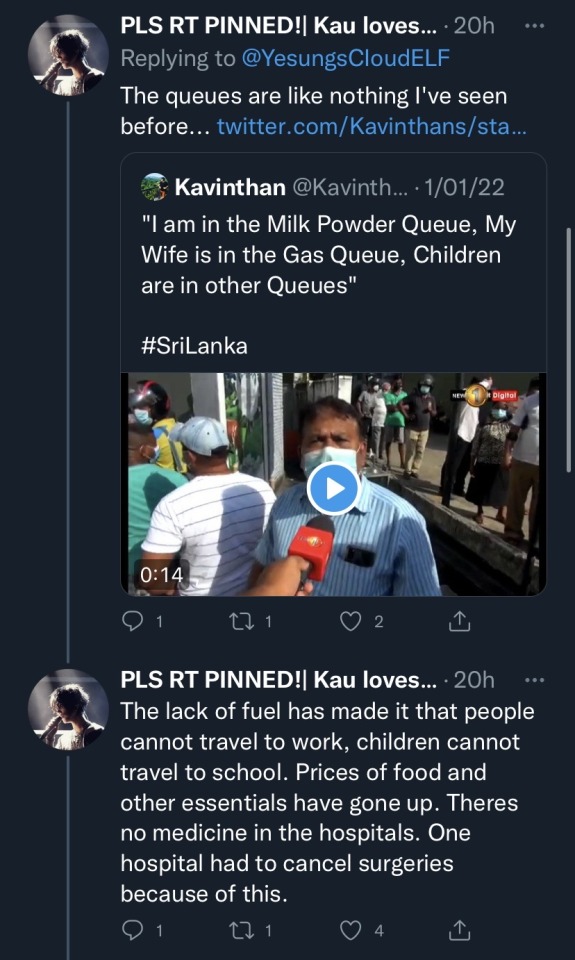

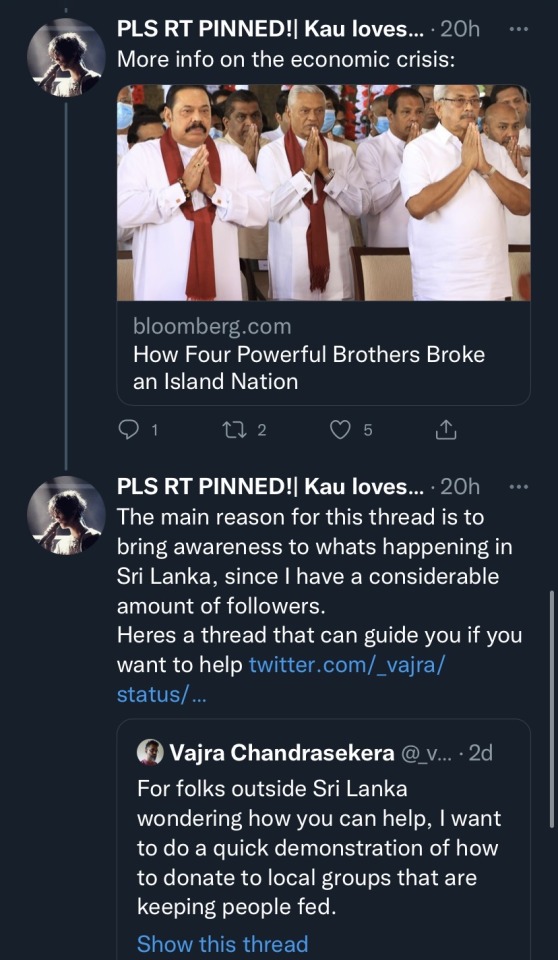

If yall want to donate here is a thread explaining how to do it:

If you can donate please do
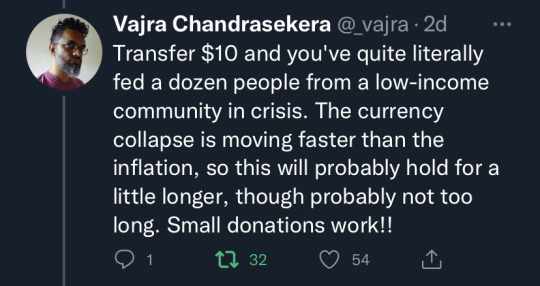
#sri lanka#sri lanka crisis#signal boost#idk what else to tag#pls reblog#dark academia#sri lankan culture#light academia#desi culture#south asian culture#south asian academia#sri lankan academia#south asia#history#gohomegota
146 notes
·
View notes
Note
Fuck the Rajapaksas!
Why are these happening in Sri Lanka?
*takes a deep breath*
We are currently facing a severe economic crisis. Sri Lanka has survived 30 years of civil war, Easter Sunday bomb attacks in 2019 and of course the covid pandemic.
But nothing has ever gotten this bad. Of course, all of the above (and many others) have had a negative impact on our economy. This is not something that happened suddenly. Our economy has been in decline for a long time now.
But the primary cause is our corrupt leadership (As you can see from the arbitrary arrests and curfews being imposed currently).
70% of Sri Lanka's budget is controlled by the Rajapaksa family. By a single family who runs the government.
Our president is Gotabaya Rajapaksa. Our prime minister is Mahinda Rajapaksa (former president). Our finance minister is Basil rajapaksa. Chamal Rajapaksa is the minister of irrigation. They are brothers!
They are more rajapaksas in our parliaments - handling different ministries - including the youth ministry and one of them is a cabinet minister.
Basically, they have been running our country and controlling our budget and basically exploiting the fuck out of us. While many of us knew it was bad, there is nothing we could because they are political majority in the country.
But now they've run us to the fucking ground. We have power cuts lasting up to 13 hours a day. The dollar rate has sky rocketed (from 170 rupees to 330). We have no fuel (hence no electricity). Public transport is basically nonexistent. Schools have closed down. Hospitals are operating at capacity - and without power. There are people - I shit you not - who only eat one meal a day because our cost of living is through the roof. Because we have no foreign currency in the country, we can't import anything because we can't pay for anything. This means we don't have medications, basic food staples and many other things because we important all of this.
In essence, it is a clusterfuck. Biggest in our history.
So, people are really fucking frustrated - and rightly so. There are riots and protests in the streets every day. Journalists and activists are being arbitrarily arrested (and assaulted) under the PTA (prevention of terrorism act) because anyone who speaks against the government is now being labelled as "extremists".
I don't know how or when things are going to get better. It doesn't look like it's going to happen anytime soon because things are really, really bad right now. I only hope the damage will be minimal as we find our way out of this possibly in the next few months (or years).
#sri lanka#gohomegota#SLcrisis#dark academia#sri lankan culture#light academia#desi culture#south asian culture#south asian academia#sri lankan academia#south asia#history
2K notes
·
View notes
Text


SENSATIONAL SWEET AND SPICY SAMBOLS
“The most memorable experience I had in Sri Lanka was learning to cook traditional recipes with two women in the local village. It was likely one of the most eye-opening culinary experiences I’ve ever had – not only learning from such passionate and experienced cooks, but seeing their traditional kitchen, tools, and techniques really inspired me.
Take their stove, for example. A large clay bench with large mounds molded into it held the earthenware pots in place, and the heat underneath was adjusted by adding more sticks to the fire, or taking them away. Genius. Above the stove was a large wooden wrack to hang beans, seeds, and herbs for fast drying, which I thought was a brilliant way to take advantage of the residual heat. Ingredients were prepped on the floor, since it’s cooler down there, and also nice to sit while you’re working. The knife to cut veggies was actually attached to a stool, and instead of holding the blade, you hold the vegetables and basically drop them on top, slicing them in the air to fall onto a grass mat. The sambol was made by grinding all the ingredients together on a huge flat stone designed specifically for this task, and as such took all of ten seconds to prepare. Spoons were made from dried coconut shells. The plates were made of woven grass, topped with fresh lotus leaves from the nearby creek. The leaves protected the plates from the saucy curries, and when you were finished your meal, you’d discard the leaf into the compost, so that there was literally nothing to wash!
This day made me take a long hard look at how much stuff I use in the kitchen. Water, electricity, appliances – these women were literally using nothing but things from the earth around them and it made me wonder how we’ve come so far from that connection. Cooking has become so overblown, and it was this experience that reminded me to cook simpler and eat simpler. Get closer to the earth. I don’t have some grand solution, but it’s food for thought.”
857 notes
·
View notes
Text
If you can, please donate so my best friend can complete their Human Rights degree and not have to move back to their home country that will persecute them for their sexuality.
“If the world’s benevolence were solid and well-spread; oppression would be seldom, but empathy is not enough - We can create mechanisms that cannot be warped by greed, the lust of power, and sadistic desire.”
#donate#signal boost#gofundme#human rights#someone help#help#poc lgbt+#oppression#academia#reblog please
8 notes
·
View notes
Text
Do you ever get hit with the sudden reminder that your culture’s traditional outfits isn’t some ancient, archaic form of dress but a still living, breathing, thriving form of fashion with its various trends, styles, and aesthetics?
#sri lanka#dark academia#sri lankan culture#desi culture#light academia#south asian culture#sri lankan academia#south asian academia#south asia#south asian dark academia#poc dark academia#fashion#aesthetics#south asian traditions#cultural clothing#history#art#culture#my mom showed me different styles of saree sleeves and the realization hit like a ton of bricks
127 notes
·
View notes
Note
hey are u still active? because i dont really know where else to learn about my cuture which sucks :(
No sorry 😣 I’m not active these days because I’m juggling a masters program and finding a job. I might be active again in the future when I have more time because I genuinely enjoy researching about our culture.
In the meantime, may I suggest taking a look at @lankanhistory and @dravidaarasi on insta for some great Sri Lankan history content.
The website everyculture.com also covers an impressively broad range of Sri Lanka’s overall history, culture, and present day social norms. I also have some academic sources cited in my last ask. Hope this helps till I become active again 🙏🏽
Thank you for your support 💞
8 notes
·
View notes
Note
Never too tired to dismantle internalized colourism!
Consuming dark academic content has always like walking into a garden that was previously used as a minefield.
There’s such beautiful and soothing content and then sometimes you see something that reinforces the internalized colorism you worked so hard to unlearn.
We all consume content; be mindful of the effect it has on you.
do you have any articles for getting over internalised colourism? i tried to find resources online but everything was for black people and i’m desi
I'm getting a lot of desi-specific articles once you add ''South Asian internalised colourism'' to the search bar, but most of them don't actually give any tips.
I personally suggest:
Throw away all your skin-lightening products. This includes things like face-washes and masks that advertise ''light, glowing skin''.
Stick to your usual skin care routine, but aim for healthy skin, not paler skin
Eat foods rich in vitamin E, like almonds and fish. They give you healthy, shinier skin.
Stay away from Bollywood in general. We all know how much they worship light skin and it can cause unconscious internalisation of their colourist ideals
Skip adverts of Dabur creams, L'Oreal etc, that advertise with models with unnaturally pale skin.
Enjoy the sunlight. Feel how lovely and warm it is on your skin once you stop worrying how ''dark'' it'll become. (Do wear sunscreen of at least SPF 30)
Steer clear of all the wonderful colourist aunties who just love to shame you for everything, from your weight and marks, to your body hair and your skin tone.
You can even try telling them how damaging it is as a whole to society to value lighter people over darker people. You might end up changing their minds!
Southern Indian media in general tends to have darker skinned actors in roles than Northern India, and colourism is slightly less wide-spread there. Try watching those instead.
Call people out whenever you say them say something colourist. I know this can be hard, especially if you're an introvert, but it helps work over your own biases.
Try these articles:
youtube
Feel free to add on!
#sri lanka#sri lankan culture#colourism#desi dark academia#desi#south asian#south asian culture#sri lankan dark academia#poc dark academic#dark academic#dark academia
154 notes
·
View notes
Photo

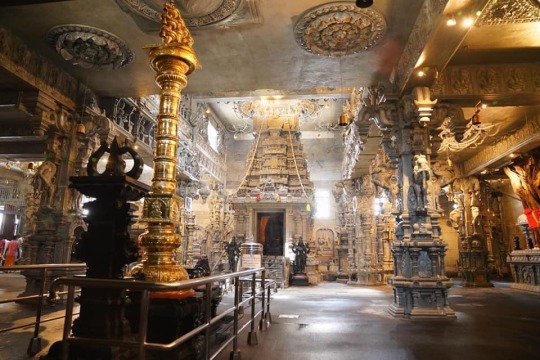

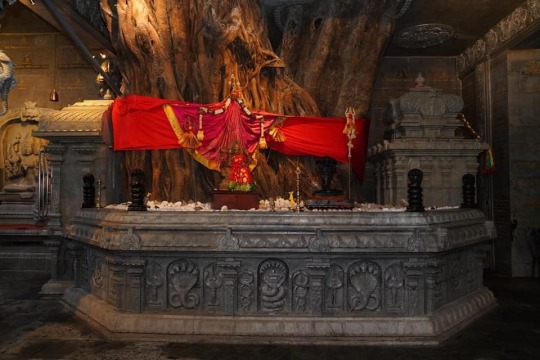
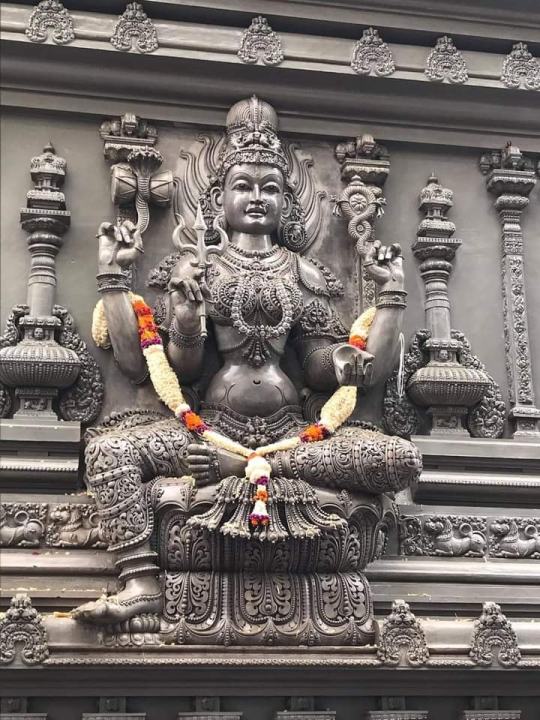
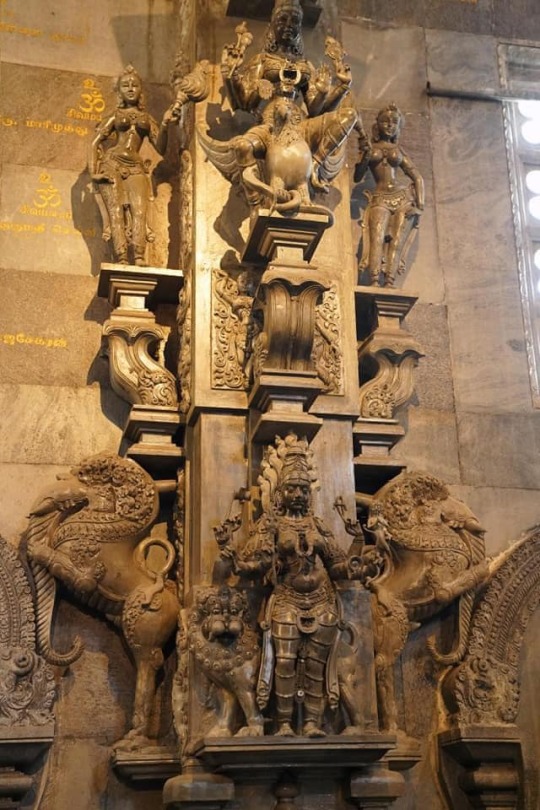
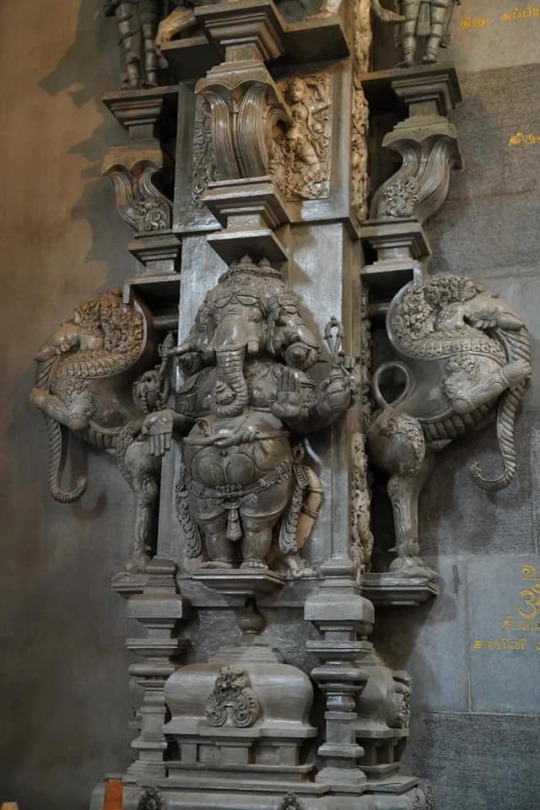
Mayurapathi Patrakali temple, Colombo, Sri Lanka
110 notes
·
View notes
Photo
Ancient Sri Lankan architects went off ✨

Ancient Temple Ruins in Anuradhapura in Sri Lanka.
396 notes
·
View notes
Text
There are more women at Sri Lanka’s universities – but they remain spaces dominated by men
Now is not the time for complacency. Universities should produce critical thinkers – and questioning gendered norms and expectations is a crucial part of this.
University students at protest in Sri Lanka, 2014. Photo: Flickr/Vikalpa/Groundviews. Some rights reserved.In Sri Lanka, women are more educated than men. This has been a growing trend, most stark in higher education. In 2015, 60% of enrolment in state higher education institutions was female, and 68.5% of graduating students were female. Most disciplines currently produce a higher percentage of women graduates with notable exceptions in engineering (21.5% female) and computer science (41.8% female).
But does this rise in the number of women in higher education mean that universities are more equitable or equal for women and men?
The growth in the number of in female undergraduates has resulted in more women entering academia, but it is yet not possible to discern a proportionate rise in the number of women in key leadership positions. Instead, what we have is a situation similar to political representation in Sri Lanka where women’s representation is 5% in parliament and even less in other levels of government.
The higher one walks up the academic ladder, the less gender parity we see: in 2013, women comprised half of the probationary lecturers but not even a quarter of the senior professors.
At the University Grants Commission, which manages most state universities, all Commission Members are men; in the nearly 20 standing committees, only a handful of members are women. These Standing Committees include heads of relevant institutions, Deans and Vice Chancellors. It is therefore a potent illustration of the absence of women in key positions in our universities.
The higher one walks up the academic ladder, the less gender parity we see…
According to Savithri Gunasekera, former Dean of the Faculty of Law, University of Colombo, the UGC once had a policy of assuring gender balance in university councils. Current statistics therefore represent a regressive trend.
The lack of women in leadership roles at the Federation of University Teachers’ Associations is also similar, though unsurprising considering the gendered nature of union work in general, where women are more often appointed as secretaries or treasurers and are rarely the public face of collective organising.
Is the under-representation of women in the higher echelons of university staff and administration due to unchanging gendered roles within the home?
Women may find it difficult to devote the time and energy needed to pursue careers in academia given responsibilities within the domestic sphere. Female academics with children are often unable to leave the country to obtain graduate degrees, thus contributing to a smaller pool of female candidates for higher positions. It may also be that both women and men continue to perceive women’s role in higher education as that of ‘teachers’ (or service providers) rather than leaders.
Growing conservatism
Parallel to the under-representation of women in university staff, committees and unions, there is an insidious growth of conservatism on Sri Lankan campuses most visible in a dress code imposed mainly, although not exclusively, on women.
Asoka de Zoysa, a Sri Lankan academic, points out that the sari has become synonymous with appropriate dress for women at educational institutions today. Some university officials have demanded that female academics wear the sari, either through explicit verbal directives or more indirectly. Not only is it a signifier of modesty (good Sri Lankan women wear sari) but also of professionalism.
Conformism in dress signals conformism at a deeper level in higher education…
In my own experience as a Sri Lankan academic, female academics come under pressure to wear the sari for lectures, examinations and meetings. Female students in many universities are also under pressure to dress modestly. Thus many students, with the exception of some (either due to department culture or social class), refrain from wearing sleeveless, shorter than knee-length clothes or clothes that are form-fitting.
Academics at a protest in Sri Lanka, 2011. Photo: Flickr/Vikalpa/Groundviews. Some rights reserved.While it is women’s attire that became the talking point in universities, growing formalism in male academic attire is noticeable as well. An informally-dressed male academic – in a loose shirt, t-shirt or jeans – is unusual at Sri Lankan universities today, and students in ‘different’ attire, e.g. dhotis or three-quarter length pants, have faced harassment in some universities.
Conformism in dress signals conformism at a deeper level in higher education. How do we sustain spaces of critical thinking, and diverse approaches to teaching and research practices, when difference in the more overtly visible aspects of academic life is unacceptable? Without accepting and standing up for non-conformist men and women in academia, how do we build institutions of learning that are acceptable of differences of thought?
Ragging
Ragging – the ritualised hazing of first year undergraduates which takes place in Sri Lankan universities – is also a site of gendered violence, with its severity differing according to university and faculty.
Such differences are erased in many media accounts of ragging, which also ignore its gendered aspect. There are also few studies on this, with an exception being Eshani Ruwanpura’s research on female sexuality which discusses ragging at the University of Kelaniya.
One of the primary reasons for ragging to continue is its ties to student political activity. And student unions, which control and plan ragging, are almost exclusively male.
Students that stand out as 'different’ are targeted for the worst forms of ragging…
Ragging is more often by male students, reflecting the gendered characteristics of student politics and gendered norms that prohibit women from behaving in a ‘masculine way’. For instance, raggers are expected to use abusive language, including swear words in public spaces which is taboo for Sri Lankan women.
Meanwhile, all first-year students are coerced into dress codes: more formal office attire for men (shirts tucked-in, formal pants, closed shoes, no t-shirts or jeans), with female students expected to wear long sleeves, high necklines, long skirts and refrain from wearing jewellery, make-up, or jeans.
Students report that although the violence of ragging is directed at all first-year students, those who stand out as 'different’ due to their gender identity or social class are targeted for the worst forms.
Part of ragging also takes place in university accommodation in the evening or at night, which means that students who are economically disadvantaged (who are unable to find outside accommodation and live in university dormitories) are ragged more often. Over the past two decades, the ragging period has also increased (from about two to almost five months), and even longer for some female undergraduates.
While both male and female students undergo sexual harassment and abuse as part of ragging, the severity may differ according to university. Even though there is a general acceptance that male students will not physically touch women students during ragging, exceptions to this have been reported. Sexual abuse complaints by students who are ragged are rare, with reports of sexual abuse faced by male students the least discussed. A newly set up portal to complain about ragging can help, but needs the full cooperation of the university population to be successful. …universities in Sri Lanka continue to be spaces dominated by men.
Despite the disproportionately larger numbers of women joining higher education as students and staff, universities in Sri Lanka continue to be spaces dominated by men.
The presence of men in positions of authority would not be a concern if male academics were feminist in practice. This has not been the case in general. Universities are spaces that should lead progressive thinking in the country, while producing progressive and critical thinkers. Questioning gendered norms and expectations is a crucial aspect of this.
One way to address these issues is the time-honoured practice of putting in place mechanisms that will actively encourage gender equity: institutions that work on issues of gender, along with the establishment of protective mechanisms that take violations of rights – including sexual harassment and abuses during ragging – seriously.
Now more than ever, with a higher number of women in universities, it is not the time to be complacent. Also disturbing is the unquestioned inverse trend: what does the absence of male students in higher education mean for the country? What socio-political changes does this reality signal?
Rights:
CC by NC 4.0
from openDemocracy http://ift.tt/2qhMM7d
via IFTTT
#Sri Lanka#Sri Lankan Academia#Desi Academia#South Asian Academia#Ragging Culture#Toxic Academia#Bullying#Sri Lankan Culture#South Asian Culture#Desi Culture#Sri Lankan Universities#Female Academics#Misogyny#Tradition#Conservatism#Academic Progress
19 notes
·
View notes